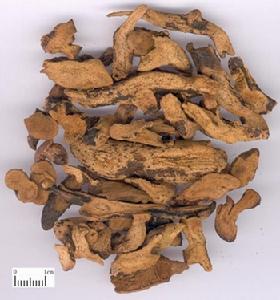骨碎補
The Processing of 骨碎補
Origin
The dry root tuber of perennial overgrowth fern plant Drynaria fortunei (Kunze) J. Sm. of family Japanese Polypody Rhizome.
Location
Guangdong, Guangxi and Sichuan provinces in China.
Harvest
Collected all the time.
The actual smell and taste
Light smell and light taste.
Best quality
Big, brown.
Processing
Unprocessed or stir-baked with hot sand.
The Effect of 骨碎補
Property
Bitter, warm; liver and kidney meridians entered.
Actions
Activate blood and cure trauma, tonify kidney.
Indications
A. Traumatic injuries, injuries of soft tissue and bone, stagnant swelling and pain
This herb enters liver and kidney meridians and can activate blood, dissolve stasis, reunion of fractured tendons and bones, resolve swelling and alleviate pain. It is indicated for traumatic injuries, injuries, congestion, swelling and pain. This herb enters kidney and treat bone so named after its major indication of soft tissue injury and broken bone. It also has the actions of tonifying kidney and strengthening bone besides activating blood, curing trauma and alleviating pain. It is the commonly used herb especially for the syndrome of soft tissue injury and bone fracture in traumatology because it moves and dissolves qi and blood stagnation due to traumatic injuries and stops bleeding due to incised wound and broken collaterals. It is soaked in wine for both internal and external application or made decoction for oral taking or combined with blood-activating analgesics and bone injury and trauma-healing and bone-reuniting herbs. For instance it is combined with Mo Yao and Zi Ran Tong in Gu Sui Bu San from Tai Ping Sheng Hui Fang.
B. Lumbago, weakness of legs, tinnitus, deafness, toothache, long-term diarrhea caused by kidney deficiency
This herb warms and tonifies kidney yang, strengthens tendon and bone, replenishes deficiency. It is indicated for all the syndromes caused by kidney deficiency such as lumbago, weakness of legs, tinnitus, deafness and toothache. It also can tonify kidney yang that aims at replenishing fire to generate earth to stop diarrhea. For lumbago, atrophy and weakness of feet and knees due to kidney deficiency, it is combined with liver and kidney tonics and tendon and bone-strengthening herbs such as Du Zhong, Xu Duan and Niu Xi. For tinnitus, deafness and toothache due to kidney deficiency, it is combined with kidney tonics, essence-replenishing and fire-purging herbs such as Shu Di Huang, Shan Zhu Yu and Ze Xie. For long-term diarrhea due to kidney deficiency, it is used singly or combined with kidney and spleen-warming and diarrhea-checking herbs such as Bu Gu Zhi, Yi Zhi Ren and Wu Zhu Yu.
In addition, it is used in treatment of alopecia areata, vitiligo and so on.
Dosage and Administrations
Decoct 10~15 g. Proper dose for external application.
Cautions
This herb is warm that can invigorate yang. Use with cautions for the yin deficiency and internal heat.

